A new duvet cover is an easy way to give your bedroom a style makeover. It can also upgrade your sleep, depending on the kind of cover you choose. Here are the key factors to consider when choosing a duvet cover, so your next purchase is safe, stylish, and sustainable.
Table of Contents
- Duvet cover materials and chemicals of concern
- How to size your duvet cover
- Duvet cover enclosure style
- Duvet cover convenience – special features to look for
- Why thread count matters in a duvet cover
- Why duvet cover weaves matter
- Duvet quality – what makes a duvet cover durable?
- Duvet cover care and maintenance
- Duvet cover certifications
- End-of-life and duvet cover recycling
- Final thoughts on factors to consider when choosing a duvet cover
Color and pattern are usually top of mind when selecting a new duvet cover. If you already have sheets you love, it’s best to choose a new duvet cover to match. This helps to keep your bedroom aesthetic calm, which supports better sleep. We talk more about how to match sheets, shams, and duvet covers here.
Style isn’t everything though. Here are other factors to consider when choosing a duvet cover:
- Type of material
- Manufacturing processes (any toxic chemicals?)
- Size
- Enclosure style (zipper, buttons, or snaps or poppers?)
- Convenience (corner loops, mainly)
- Thread count and weave
- Breathability and durability
- Care and maintenance
- End-of-life disposal and recycling.
Let’s go through each factor in turn, so you can make an informed choice for your next duvet cover purchase.
Duvet cover materials and chemicals of concern
We look at the best natural materials for sheets, shams, and duvet covers in depth here. And we go into some depth about chemicals of concern in this kind of bedding here.
The short version is that when choosing non-toxic, eco-friendly duvet covers that will perform well and last a long time, you want to avoid any toxic chemicals and look for natural fibers such as:
- Organic cotton
- Hemp
- Linen.
At a push, you might consider more eco-friendly bamboo or a bamboo blend with cotton or linen. Some silk duvet covers are also made in a more eco-friendly way, though these are rare and expensive.
Always look for cotton that is certified organic. Hemp and linen tend to be grown under organic conditions even if not officially certified, so GOTS or USDA Organic matter less for these materials.
How to size your duvet cover
You want a bit of drape to your duvet, which means a duvet insert is typically a bit larger than its corresponding mattress size. As such, a duvet cover will also be larger than the top surface of your mattress.
Duvet covers tend to come in standard sizes – full, queen, king, etc. – but some are wider or longer than others. The best way to choose a duvet cover that will fit is to:
- Measure your duvet insert (width and length from seam to seam)
- Decide if you want a snug or loose fit (more on this below)
- Consider the loft of your duvet (and measure at its loftiest).
A snug-fitting duvet cover will usually be a couple of inches shorter and narrower than your duvet insert. This kind of fit can help fluff up a less fluffy duvet and keep an oversize duvet from touching the floor.
The most common practice, though, is to choose a duvet cover that measures up to two inches longer and wider than the duvet insert. This ensures the duvet as a whole lies flat and has a relaxed, airier fit.
What happens if your duvet cover is too big or too small?
Wherever possible, avoid trying to cram a duvet insert into a duvet cover that’s too small. I’ve done this and it looks terrible and lumpy and is annoying to sleep under. The material bunches and creates cold and hot spots. Poorly fitting duvet covers also mean the entire duvet is more likely to migrate when you or your sleep partner move.
On the flip side, I’ve also had to use an oversize duvet cover for a smaller duvet insert, and this also looks terrible and is irritating for sleep. The excess material looks sloppy and feels flappy, especially if you’re an edge-sleeper like I am.
Duvet inserts are also much more likely to move around and bunch up in a duvet cover that’s too large. And if the insert is a lot smaller than the cover, you might not be able to make use of any corner ties or snaps. Again, this can create unsightly lumps and hot and cold spots.
Duvet cover enclosure style
Personally, I’m a big fan of buttons for duvet covers. It’s so much easier to sew a loose button back on or even replace a lost button, compared to the skill, time, and expense involved in replacing a broken zipper or poppers/snaps. Poppers and snaps also tend to be made of plastic, while buttons are available made of natural materials such as wood, cork, or even metal.
Zippers also have a nasty habit of snagging duvet cover material, especially if you forget to zip up the cover inside out on laundry day. Zippers can also catch on your duvet insert, which could tear it.
On the plus side, zippers work well to contain a duvet insert that’s a little bigger than the duvet cover. If you’re going for that fluffy, overstuffed look, then, a zipper style is a good choice.
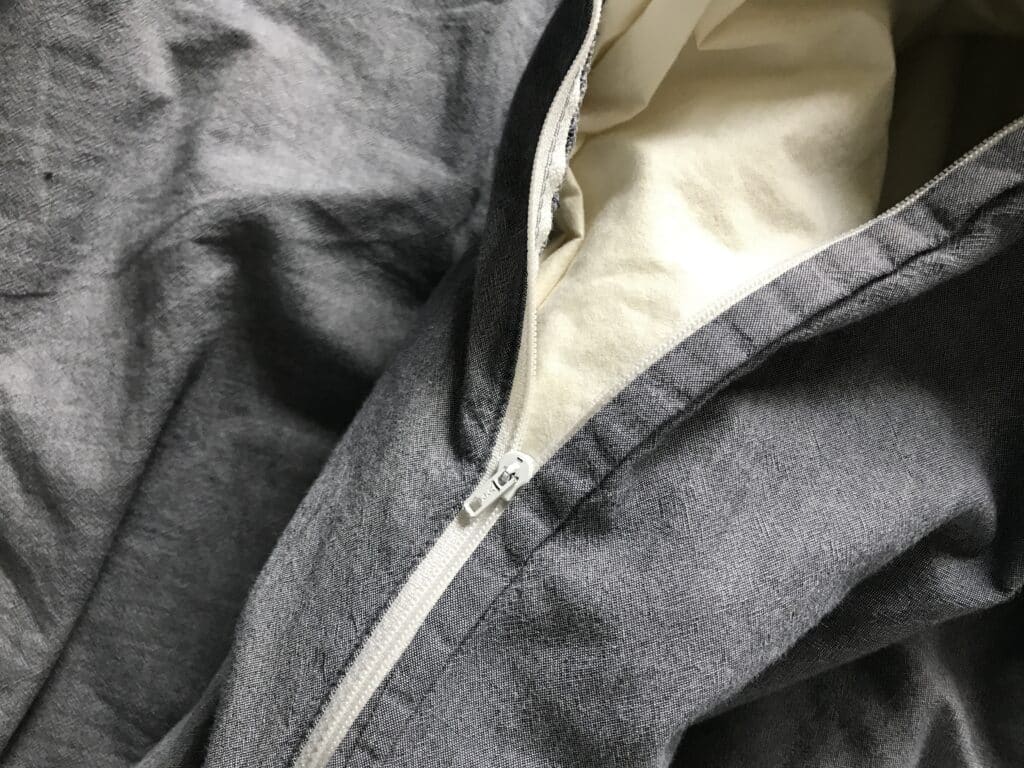
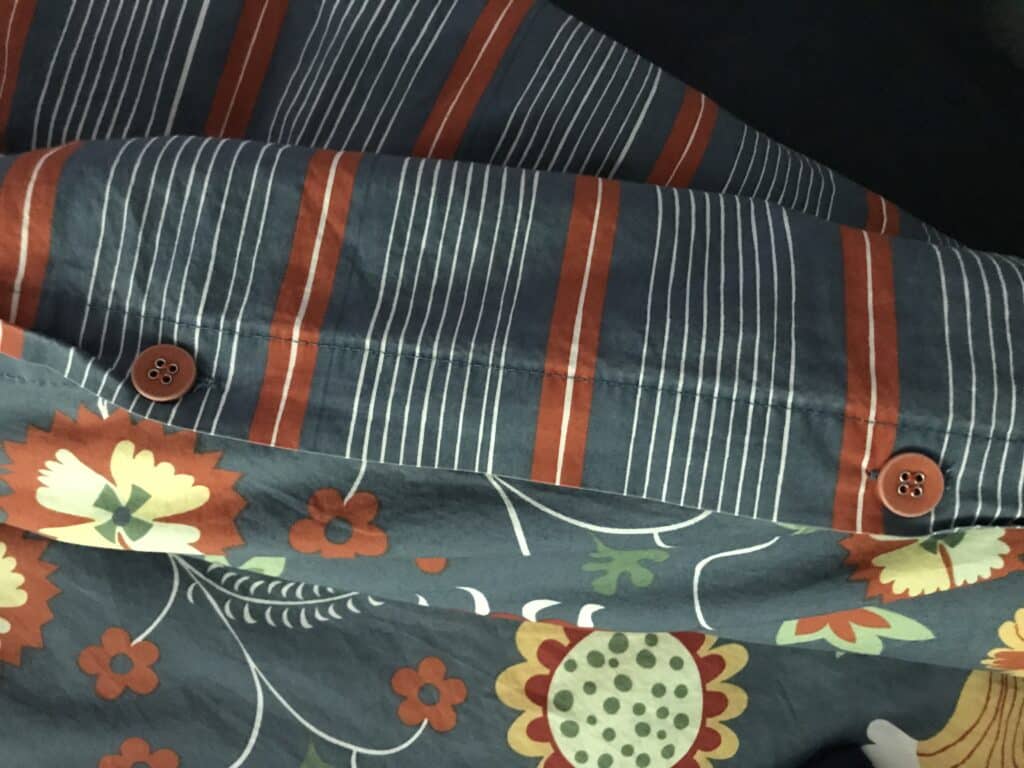
Duvet cover convenience – special features to look for
Duvet covers sometimes have corner loops or hanging snaps that clip to or around a duvet insert. These are designed to help keep the corners of your duvet in place, preventing bunching and clumping.
If you’re a very active sleeper with an oversize duvet cover, these are a good thing to look for. The same goes if you’re using a down or feather duvet or an all-season duvet that comprises two duvet inserts clipped together in some way.
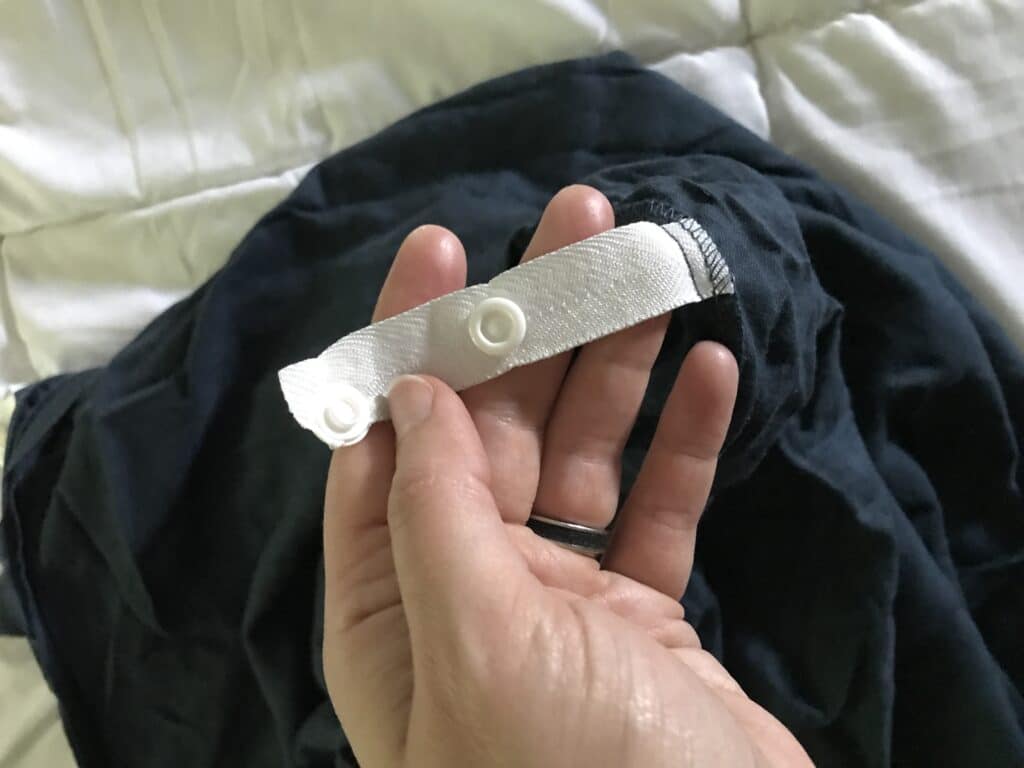
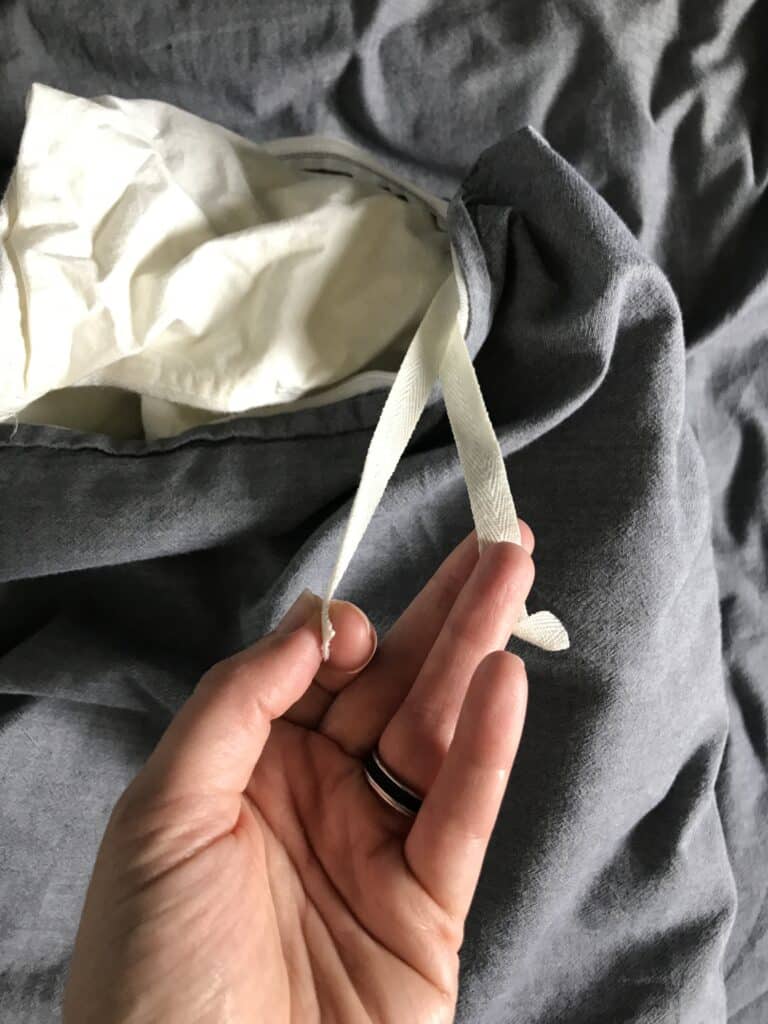
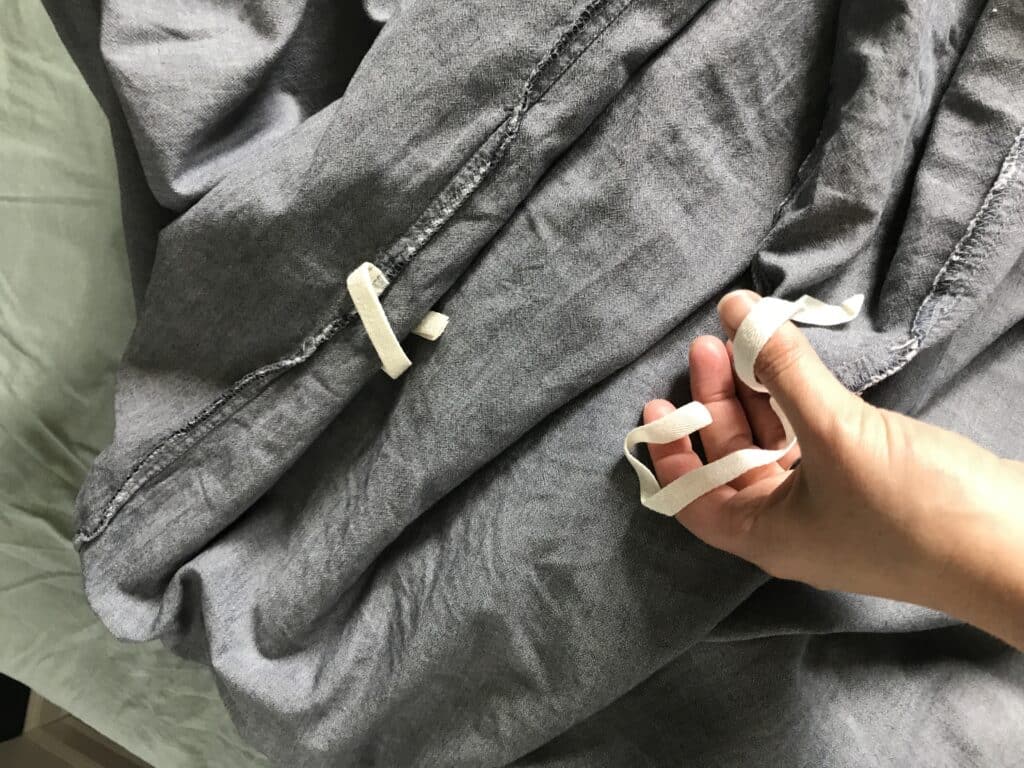
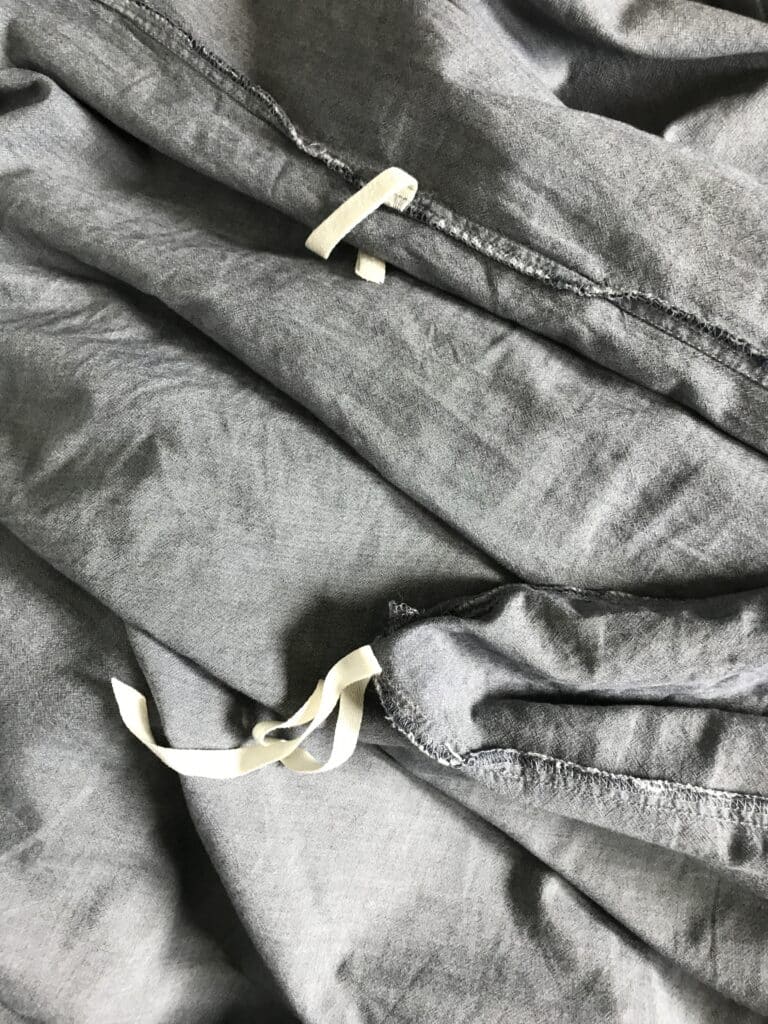
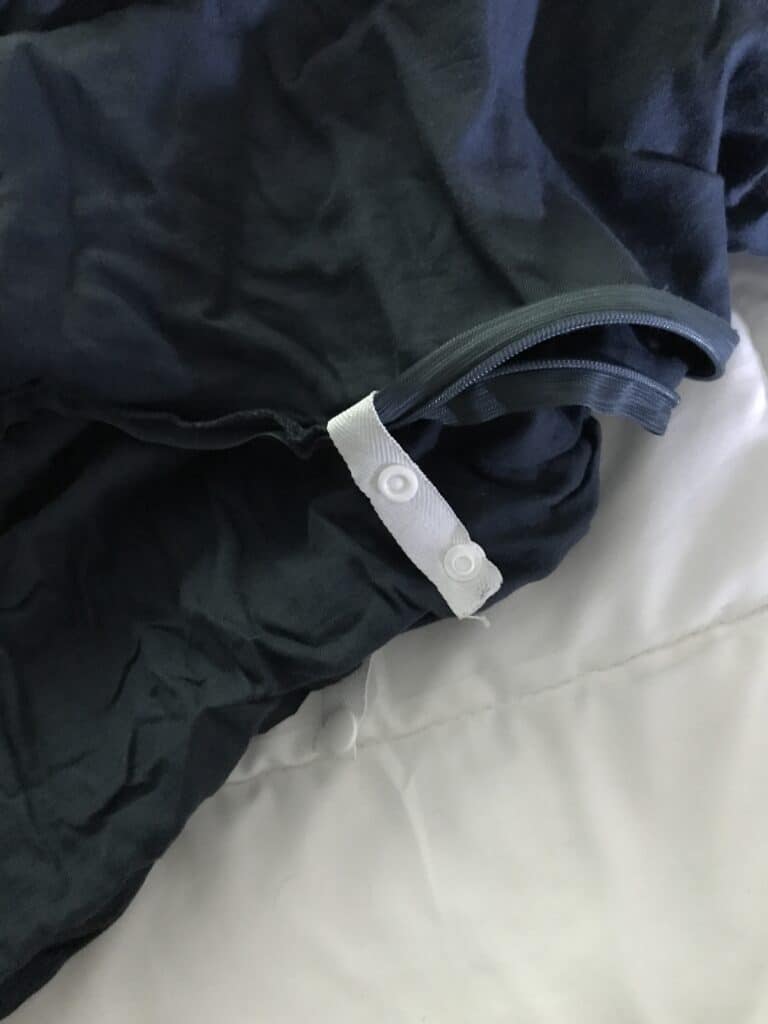
I’ve never felt the need to use these corner ties, personally, but I don’t own a down or feather duvet that requires fluffing every morning. If I did, I could absolutely see why you’d want to avoid accidentally shaking your duvet around in the cover.
Most duvet covers have a plain print, woven pattern, or a single color. However, some have embellishments or embroidery. This kind of decoration can be fun but is much more likely to snag and shorten the life of your duvet cover.
Why thread count matters in a duvet cover
You’re most likely to see thread count as part of the product description for bed sheets. The thread count of a duvet cover also matters though, and can affect its:
As with sheets, a duvet cover with a higher thread count isn’t necessarily better. In general, a higher thread count translates to a tighter weave and denser fabric. This also means the fabric:
A higher thread count can be good for winter and if you sleep cold but isn’t so great in summer or if you sleep hot.
Note, too, that thread counts aren’t always what they seem.
As well as thread count, the weave of the duvet cover is also important. In fact, it’s the combination of weave and thread count that really matters for durability, breathability, and weight.
Why duvet cover weaves matter
There are two main kinds of weave used for duvet covers:
- Percale
- Sateen.
If you sleep with a top sheet between you and your duvet cover, the feel of the weave might not matter so much. Weave still matters, though, for the durability, care and maintenance, and overall quality of the duvet cover.
| Percale | Sateen |
|---|---|
| More durable, even at low thread counts | Allows for a higher thread count |
| Breathable | Looks shiny (like satin) |
| Cool and crisp (great for summer and hot sleepers) | Feels smoother and softer |
| Lighter | Traps more heat |
| Not as soft or smooth as sateen | Less breathable |
| Not as insulating as sateen | More prone to snags and tears, unless thread count is high |
Want to know more about percale, sateen, and other weaves for bedding? We go deep on weaves and thread counts here.
Duvet quality – what makes a duvet cover durable?
A duvet cover can easily last for decades if you care for it well. That said, I’ve had several duvet covers rip and tear, lose zipper function and buttons, and fade. Most of the time, a higher thread count means a duvet cover will be more durable as it will be less prone to snags and tears.
However, a higher thread count can sometimes mean the cover is made with lower quality fibers that can break more easily. A higher thread count can also mean a duvet cover is heavier than necessary.
Some of the most durable duvet covers are made with long-staple or extra-long-staple (ELS) cotton. Look for Egyptian ELS cotton, pima, or Supima long-staple cotton. ELS cotton has to be single-ply and the strands must measure at least 1-3/8th inches long.
ELS cotton fibers are naturally softer and stronger and result in a smooth, flat, more durable weave that also feels soft and luxurious. The other beautiful thing about ELS cotton is that the quality of the yarn allows for a lower thread count even while maintaining durability and smoothness. The resulting sheets are lighter and more breathable too.
My experience with duvet cover thread count, weave, and fiber quality
I’m shorter than average and have shorter arms to match, which already makes it hard to put on a duvet cover. Heavier covers are even more of a challenge to put on and also require more effort to wash and dry.
Depending on the fiber and size, a wet duvet cover can be very heavy indeed. We try to line-dry as much of our laundry as possible, but I confess to mostly drying duvet covers in the dryer, especially when I was pregnant. One of our linen-blend duvet covers soaks up a lot of water and hanging this heavy cover out to dry is challenging.
I’m also a hot sleeper, so I don’t enjoy a densely woven duvet cover and sheets as they trap heat.
On the flip side, I have a dog who loves to sleep on beds, hates getting her nails cut, and digs when anxious. This means I’ve had more than a few breathable, lightweight, low thread count sheets and duvet covers rip over her twelve years of life.
The solution, in so far as there is one, has been to look for a duvet cover with an average thread count but high quality long-staple cotton fibers, such as organic ELS Egyptian or pima cotton. This kind of cover is more breathable, lighter, easier to wash, doesn’t trap heat but still holds up well and isn’t prone to snags and tears.
Duvet cover care and maintenance
Over the course of my adult life, I’ve had duvet covers made with:
- Cotton
- Poly-cotton blends
- Organic cotton
- Linen
- Bamboo linen blends
- Hemp.
What I’ve found is that organic cotton duvet covers are usually the easiest to maintain and care for, with linen almost as easy. Organic cotton duvet covers are liable to shrink a little on their first wash and maybe on a second or third wash. Some come pre-washed and won’t shrink. Avoid hot water and high heat to extend the life of your duvet cover, whatever material it is made from.
My top tips for keeping a duvet cover in good shape are to always:
- Wash the duvet cover inside out
- Zip, button, or otherwise close the duvet cover before washing
- Wash the duvet cover separately from anything that could snag it (clothes with zippers, etc.)
- Mend any budding tears or snags right away, before washing and before they spread
- Line dry where possible
- Dry on low heat with wool dryer balls to prevent tangles that can stretch the fibers
- Remove the duvet cover from the dryer and reshape while very slightly damp.
Different natural fibers have different care needs. We cover these in the following guides:
- Care and maintenance of organic cotton bedding
- Care and maintenance of linen bedding
- Care and maintenance of hemp bedding.
Duvet cover certifications
Duvet covers can come with a variety of green certifications. These may apply to the fibers that make up the duvet cover or to how it’s made, with what chemicals, by whom, and under what conditions.
In general, it’s best to look for a duvet cover with at least one, if not several, of the following seals:
- GOTS
- MadeSafe
- USDA Organic
- eco-INSTITUT.
To varying degrees, these seals help offer assurance that organic fibers are genuinely organic and that the duvet cover was made without the use of hazardous chemicals such as:
- Chlorine bleach
- Azo dyes and other dyes of concern
- Biocides
- Formaldehyde
- Synthetic materials.
Check out our guide to the most important green certifications for sheets (and duvet covers) here.
End-of-life and duvet cover recycling
The easiest duvet cover to recycle, upcycle, or otherwise dispose of is one made with natural, biodegradable materials that haven’t been treated with toxic chemicals.
At worst, this kind of duvet cover will end up in landfill and will eventually rot down without leaching any hazardous chemicals into the ground, air, or water.
In contrast to natural fiber duvet covers, polyester duvet covers cause microplastic pollution every time you wash them and at the end of life. They’re also harder to recycle because they usually comprise a mix of fibers.
Even natural fiber duvet covers may cause pollution at the end of life. This is because they’re often treated with toxic chemicals.
If you can, though, consider upcycling an old duvet cover that no longer functions as a cover. I used an old duvet cover with a broken zip and some tears to create a rug for my baby’s nursery. Here are some other creative ways to reuse and recycle old duvet covers.
Final thoughts on factors to consider when choosing a duvet cover
Choosing a new duvet cover can be fun, even though there’s a lot to think about. Before we wrap up, I also want to mention manufacturing ethics. After all, if your new duvet cover is the result of exploitative labor practices and in a way that damages the environment, it might not feel so comforting.
An ethical duvet cover is one made with regard to people, planet, and non-human animals. Look for certifications like GOTS, Made in Green by Oeko-Tex, and Fair Trade to find a more sustainable, socially fair duvet cover.
Enter your email address for 10% off organic bedding